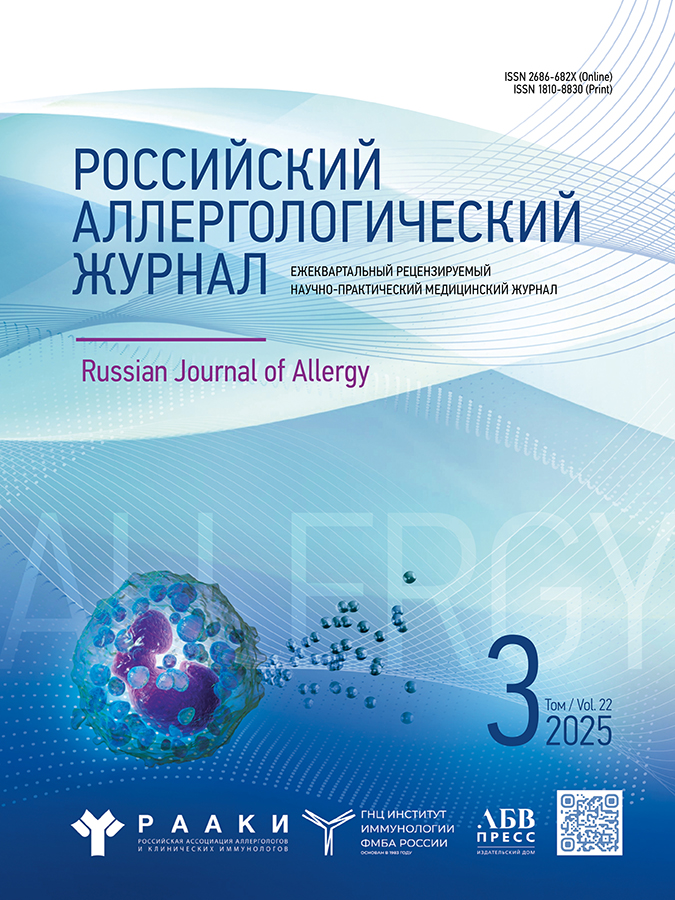Лекарственная фиксированная эритема в практике врача аллерголога-иммунолога
- Авторы: Романова ТС1, Мясникова ТН1, Хлудова ЛГ1, Латышева ТВ1
-
Учреждения:
- ФГБУ «ГНЦ Институт иммунологии» ФМБА
- Выпуск: Том 14, № 1 (2017)
- Страницы: 36-40
- Раздел: Статьи
- Дата подачи: 10.03.2020
- Дата публикации: 15.12.2017
- URL: https://rusalljournal.ru/raj/article/view/335
- DOI: https://doi.org/10.36691/RJA335
- ID: 335
Цитировать
Полный текст
Аннотация
Полный текст
Об авторах
Т С Романова
ФГБУ «ГНЦ Институт иммунологии» ФМБА
Email: ts romanova@mail.ru
г. Москва
Т Н Мясникова
ФГБУ «ГНЦ Институт иммунологии» ФМБАг. Москва
Л Г Хлудова
ФГБУ «ГНЦ Институт иммунологии» ФМБАг. Москва
Т В Латышева
ФГБУ «ГНЦ Институт иммунологии» ФМБАг. Москва
Список литературы
- Hunziker T., Kunzi U.P., Braunschweig S. et al. Comprehensive hospital drug monitoring (CHDM): adverse skin reactions, a 20-year survey. Allergy. 1997, v. 52, p. 388-393
- Turk B.G., Gunaydin A., Ertam I., Ozturk G. Adverse cutaneous drug reactions among hospitalized patients: five year surveillance. Cutan. Ocul. Toxicol. 2013, v. 32 (1), p. 41-45.
- Ozkaya-Bayazit E., Akar U. Fixed drug eruption induced by trimethoprim-sulfamethoxazole: evidence for a link to HLA-A30 B13 Cw6 haplotype. J. Am. Acad. Dermatol. 2001, v. 45, p. 712-717.
- Brahimi N., Routier E., Raison-Peyron N. et al. A three-year-analysis of fixed drug eruptions in hospital settings in France. Eur. J. Dermatol. 2010, v. 20, p. 461-464.
- Andrade P., Brinca A., Gonçalo M. Patch testing in fixed drug eruptions - a 20-year review. Contact Dermatitis. 2011, v. 65, p. 195-201.
- Ring J., Blaser K., Capron M. et al. Adverse cutaneous drug eruption. Chem. Immunol. Allergy. 2012, v. 97, p. 240.
- Korkij W., Soltani K. Fixed drug eruption. Arch. Dermatol. 1984, v. 120, p. 520-524.
- Mizukawa Y., Shiohara T. Trauma-localized fixed drug eruption: involvement of burn scars, insect bites and venipuncture sites. Dermatology. 2002, v. 205, p. 159-161.
- Sigal-Nahum M., Konqui A., Gaulier A. et al. Linear fixed drug eruption. Br. J. Dermatol. 1988, v. 118, p. 849-851.
- Senturk N., Yanik F., Yildiz L. et al. Topotecan - induced cellulitis like fixed drug eruption. J. Eur. Acad. Dermatol. Venereol. 2002, v. 16, p. 414-416.
- Guin J.D., Baker G.F. Chronic fixed drug eruption caused by acetaminophen. Cutis. 1988, v. 4, p. 106-108.
- Rijlaarsdam U., Scheffer E., Meijer C.J. et al. Mycosis fungoi-des - like lesions associated with phenytoin and carbamazepine therapy. J. Am. Acad. Dermatol. 1991, v. 24, p. 216-220.
- Shiohara T., Mizukawa Y. The immunological basis of lichenoid tissue reaction. Autoimmune Rev. 2005, v. 4, p. 236-241.
- Shelley W.B., Shelley E.D. Nonpigmenting fixed drug eruption as a distinctive reaction pattern: examples caused by sensitivity to pseudoephedrine hydrochloride and tetrahydrozoline. J. Am. Acad. Dermatol. 1987, v. 17, p. 403-407.
- Desmeules H. Nonpigmenting fixed drug eruption after anesthesia. Anesth. Analg. 1990, v. 70, p. 216-217.
- Barbaud A., Goncalo M., Bruynzeel D. et al. Guidelines for performing skin tests with drugs in the investigation of cutaneous adverse drug reactions. Contact Dermatitis. 2001, v. 45, p. 321-328.
Дополнительные файлы



